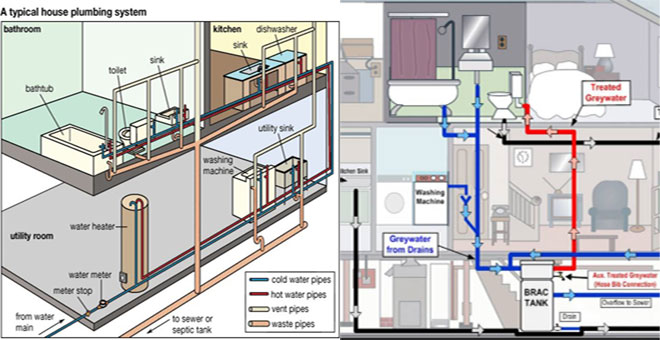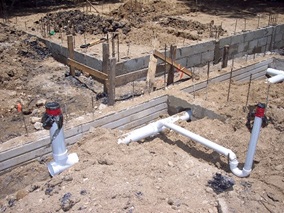How The Anatomy of Your House's Plumbing System Matters
How The Anatomy of Your House's Plumbing System Matters
Blog Article
Have you been interested in facts concerning Exploring Your Homes Plumbing Anatomy?

Comprehending exactly how your home's pipes system works is necessary for every single home owner. From delivering tidy water for drinking, food preparation, and showering to safely eliminating wastewater, a well-kept plumbing system is essential for your household's health and wellness and convenience. In this thorough guide, we'll check out the complex network that makes up your home's plumbing and offer tips on maintenance, upgrades, and handling common problems.
Introduction
Your home's plumbing system is more than just a network of pipes; it's a complex system that ensures you have access to tidy water and reliable wastewater elimination. Understanding its elements and how they work together can help you stop expensive repair services and guarantee everything runs efficiently.
Fundamental Parts of a Plumbing System
Pipes and Tubes
At the heart of your pipes system are the pipelines and tubing that bring water throughout your home. These can be constructed from numerous products such as copper, PVC, or PEX, each with its benefits in terms of sturdiness and cost-effectiveness.
Fixtures: Sinks, Toilets, Showers, etc.
Fixtures like sinks, commodes, showers, and bath tubs are where water is made use of in your house. Comprehending how these fixtures attach to the plumbing system aids in detecting issues and preparing upgrades.
Shutoffs and Shut-off Factors
Valves regulate the circulation of water in your pipes system. Shut-off shutoffs are important during emergency situations or when you require to make repair work, allowing you to separate parts of the system without interrupting water flow to the whole home.
Water Supply System
Main Water Line
The main water line attaches your home to the local water or a personal well. It's where water enters your home and is distributed to different fixtures.
Water Meter and Stress Regulator
The water meter actions your water usage, while a pressure regulatory authority makes sure that water flows at a secure pressure throughout your home's pipes system, protecting against damages to pipes and components.
Cold Water vs. Hot Water Lines
Understanding the difference between cold water lines, which provide water directly from the major, and warm water lines, which carry warmed water from the water heater, aids in troubleshooting and preparing for upgrades.
Drain System
Drain Water Lines and Traps
Drain pipelines bring wastewater far from sinks, showers, and bathrooms to the sewer or sewage-disposal tank. Traps stop sewage system gases from entering your home and likewise catch debris that might create blockages.
Ventilation Pipelines
Air flow pipes permit air into the drain system, preventing suction that might reduce drain and create traps to vacant. Proper ventilation is essential for preserving the honesty of your pipes system.
Significance of Correct Drainage
Making sure correct drainage stops back-ups and water damages. Frequently cleansing drains and preserving catches can prevent expensive fixings and extend the life of your pipes system.
Water Furnace
Types of Water Heaters
Water heaters can be tankless or standard tank-style. Tankless heating systems heat water as needed, while containers store heated water for instant usage.
Upgrading Your Plumbing System
Reasons for Updating
Updating to water-efficient fixtures or replacing old pipes can enhance water high quality, minimize water expenses, and boost the worth of your home.
Modern Pipes Technologies and Their Advantages
Explore technologies like clever leakage detectors, water-saving commodes, and energy-efficient water heaters that can save money and minimize environmental effect.
Expense Factors To Consider and ROI
Compute the ahead of time prices versus long-lasting financial savings when taking into consideration pipes upgrades. Many upgrades pay for themselves via lowered energy costs and fewer repairs.
How Water Heaters Attach to the Pipes System
Recognizing how water heaters connect to both the cold water supply and hot water distribution lines helps in diagnosing issues like inadequate hot water or leaks.
Maintenance Tips for Water Heaters
Routinely flushing your hot water heater to get rid of debris, checking the temperature level setups, and checking for leaks can prolong its life expectancy and improve energy efficiency.
Common Plumbing Concerns
Leakages and Their Reasons
Leakages can happen because of aging pipes, loosened installations, or high water stress. Attending to leakages immediately avoids water damage and mold growth.
Obstructions and Clogs
Blockages in drains and toilets are commonly triggered by flushing non-flushable products or an accumulation of oil and hair. Making use of drainpipe screens and bearing in mind what drops your drains pipes can avoid clogs.
Indicators of Pipes Issues to Look For
Low water pressure, slow-moving drains pipes, foul odors, or unusually high water costs are indications of possible pipes problems that must be addressed without delay.
Plumbing Upkeep Tips
Normal Evaluations and Checks
Set up annual pipes evaluations to capture issues early. Seek signs of leaks, deterioration, or mineral buildup in taps and showerheads.
DIY Upkeep Tasks
Easy tasks like cleansing faucet aerators, looking for commode leakages using color tablets, or shielding subjected pipes in chilly environments can avoid significant pipes issues.
When to Call a Specialist Plumber
Know when a plumbing concern needs professional competence. Trying complex repair services without appropriate expertise can result in even more damages and higher repair service expenses.
Tips for Lowering Water Usage
Straightforward habits like taking care of leaks quickly, taking much shorter showers, and running full tons of washing and meals can save water and reduced your utility costs.
Eco-Friendly Pipes Options
Consider lasting pipes materials like bamboo for floor covering, which is durable and eco-friendly, or recycled glass for countertops.
Emergency Preparedness
Actions to Take During a Plumbing Emergency situation
Know where your shut-off valves are located and how to shut off the water system in case of a ruptured pipe or major leakage.
Value of Having Emergency Situation Contacts Handy
Keep call information for regional plumbing professionals or emergency services conveniently offered for quick reaction throughout a pipes crisis.
Environmental Effect and Preservation
Water-Saving Fixtures and Appliances
Setting up low-flow taps, showerheads, and commodes can significantly decrease water use without giving up performance.
DIY Emergency Fixes (When Suitable).
Short-term repairs like utilizing duct tape to patch a leaking pipe or placing a pail under a trickling tap can reduce damage up until a specialist plumbing professional arrives.
Conclusion.
Understanding the composition of your home's plumbing system equips you to preserve it successfully, saving money and time on repair services. By complying with normal upkeep regimens and remaining educated regarding contemporary plumbing innovations, you can ensure your plumbing system operates efficiently for years to come.
HOW YOUR PLUMBING SYSTEM WORKS
Which Pipes Do What?
Blue lines = fresh water supply entering the building Red lines = hot water supply entering the building Grey lines = pipes carrying waste away from the building and venting pipes carrying gases away from the building (through the roof) YOUR MAIN PLUMBING SYSTEMS
There are two main plumbing systems that support your home s basic plumbing needs one that brings clean water into your home, and one that sends dirty water away from your home. Connected to the toilet, bath, shower, and other faucets in your home, these two systems keep your water flowing in the right directions.
ACCESSING FRESH WATER
Fresh and clean water is brought into your home through the main water supply line . Filtered through one pipe, this water is pressured to flow into the various fixtures in your home at any given time.
This water can be sourced from a well located on your property, a pond or river (mostly cottages), or, as in most cases, from the city s municipal water treatment centre. However, it is important to note that water that is untreated, such as the water siphoned from ponds or rivers, may not be safe to drink. Personal water supplies always need to be treated for hardness and contaminants before consumed.
MUNICIPAL WATER SUPPLIES
Improve taste and odour Remove sediment Eliminate hardness Reduce chlorine COLD WATER SUPPLY VS. HOT WATER SUPPLY
Cold water flows into your home or building through the service line, which then distributes hot or cold water to your fixtures. This line is most commonly run through a central column that runs floor to floor. Hot water runs in short and straight pipes as the longer the pipeline, the more heat that will be lost in the transfer. Having shorter pipes also allows residents to access hot water more quickly.
WASTE WATER SYSTEM
Your wastewater system is divided into two parts pipes that send wastewater away from your home and venting pipes that send sewer gas away from your home. Sewage water travels through pipes that flush the water and waste towards local sewers that are operated and managed by your city or town. Most sewer systems rely on gravity to move the wastewater to where it needs to go.
The further away from your toilet or sink, the larger wastewater pipes become. This allows for waste to be disposed of from various parts of your home or business at once without pipe blockages. The angle and flow of these pipes are also essential for keeping your waste pipes clear of build up.
https://harrisplumbing.ca/how-your-home-plumbing-system-works/

I was shown that report about Anatomy of a House: Understanding the Components from a good friend on a different web address. If you please take the opportunity to distribute this blog post if you appreciated it. I cherish your readership.
Book An Appointment Report this page